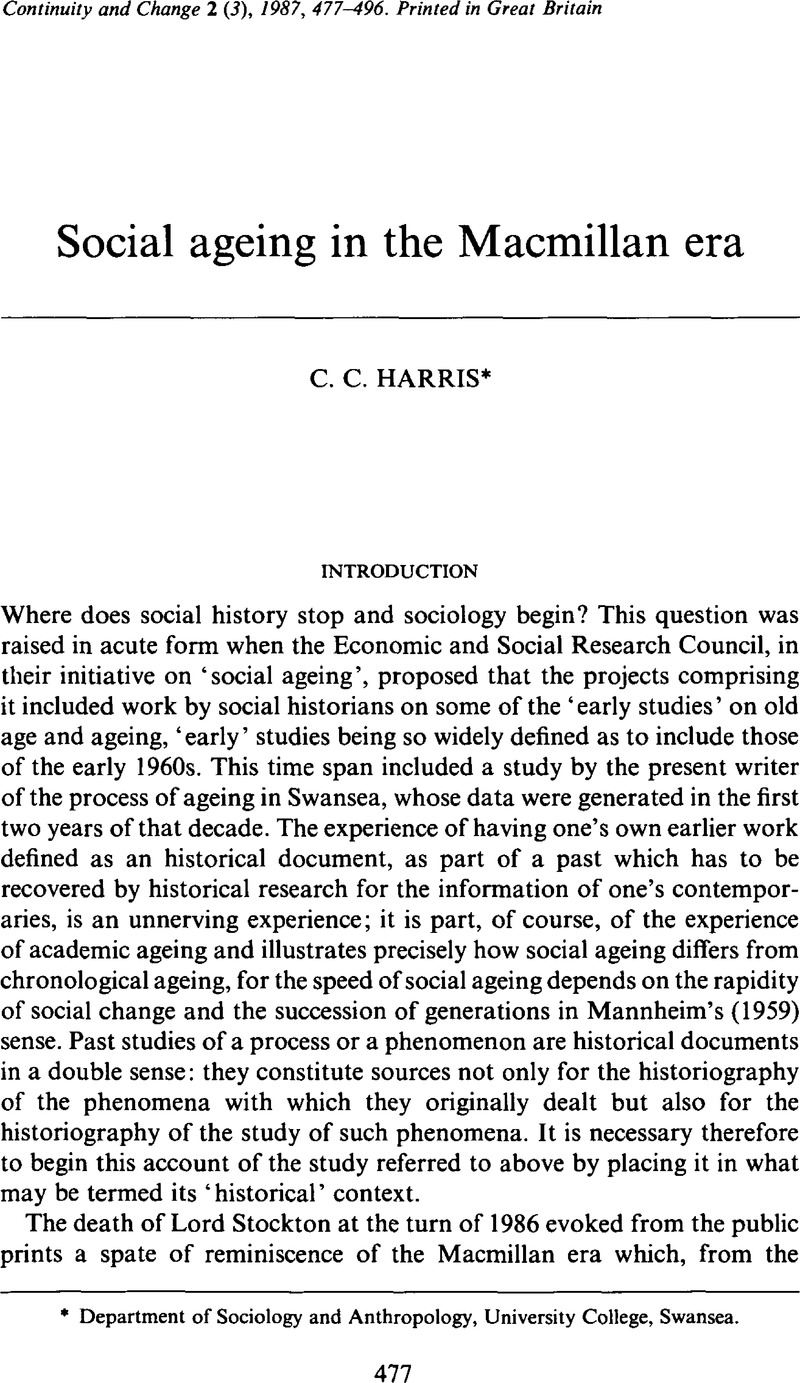Article contents
Social ageing in the Macmillan era
Published online by Cambridge University Press: 11 November 2008
Abstract

- Type
- Articles
- Information
- Copyright
- Copyright © Cambridge University Press 1987
References
ENDNOTES
1 Young, M. and Willmott, P., Family and kinship in east London (London, 1954)Google Scholar; Townsend, P., The family life of old people (London, 1957)Google Scholar; Marris, P., Widows and their families (London, 1958).Google Scholar
2 For an overview see Frankenberg, R., Communities in Britain (London, 1966Google Scholar) and Bell, C. and Newby, H., Community Studies (London, 1971) for discussion.Google Scholar
3 For an example of some of the uses to which they were put see Klein, J., Samples from English culture (two volumes) (London, 1965).CrossRefGoogle Scholar
4 Riesman, D., The lonely crowd (Yale, 1950).Google Scholar
5 For a discussion of this tradition see Bulmer, M. ed., Working class images of society (London, 1975).Google Scholar
6 See Rosser, C. and Harris, C. C., The family and social change (London, 1965).CrossRefGoogle Scholar
7 The Swansea sample was a two per cent quasi random sample of the population of voting age of the then County Borough of Swansea. The achieved sample was 1,962 of whom 433 were of pensionable age.
8 Poverty was denned as follows: for a non married person, a weekly income of less than the statutory pension of £2. 10s.; for a married couple, less than £3. Poor economic circumstances refer to non married persons with a weekly income of less than £3, and to married couples with a weekly income of less than £6.
9 Townsend, P., The last refuge (London, 1962).Google Scholar
10 Smith, D. H. and Parker, R., ‘Changes in the use of institutions in England and Wales between 1911 and 1951’, Manchester Statistical Society Transactions (1959).Google Scholar
11 Tunstall, J., Old and alone (London, 1966).Google Scholar
12 Goody, J. ed., The development cycle of domestic groups (Cambridge, 1962).Google Scholar
13 For a discussion see Harris, C. C., ‘The individual and society, a processual approach’, in Bryman, A., Bytheway, B., Allatt, P. and Kiel, T. eds., Rethinking the life cycle (Basingstoke, 1988).Google Scholar
14 Women typically retained a familial role in relation to their grandchildren until they were 74, while men lost their occupational role at 65 when their wives were 63. Hence, women still retained a grandmaternal role when their husbands died aged 75, the women themselves were 73. They lost their parental role however immediately after the loss of their spouse. (It has been arbitrarily assumed that women's familial role ceased when their youngest grandchild reached 16.)
15 Proportions with living siblings seeing siblings within the week previous to interview fell between the 20–39 and 70 + age groups from 57 to 43 per cent in the middle class; from 65 to 44 per cent among working-class men, and from 74 to 43 per cent among working-class women. Contact with siblings of the spouse showed even greater falls.
16 The original analysis involved forty-four tables and required holding six confounding variables constant and controlling for kin contact and travelling while examining interphasal shifts in an associational participation index within age cohorts and cannot be presented here. Increases in associational activity in the final phase were clearly established for working-class women, but associational participation declined for working-class men. An increase in participation was however shown to be associated with retirement for this category. In other words, in the working class increases in participation were shown to be associated with the loss of the major adult role as predicted. In the middle class associational activity increased among men with movement into the final phase at whatever age it took place, but only increased among those middle-class women who moved into the final phase in middle age. However, changes in any direction in an associational activity were accompanied by changes in the opposite direction in kinship activity, thus supporting the hypothesis that where increased activity is not possible in one social sphere, the other will be utilised to compensate.
17 Rose, A. M., ‘A current theoretical issue in social gerontology’, The Gerontologist 4 (1964); 46–50.CrossRefGoogle ScholarPubMed
- 1
- Cited by




